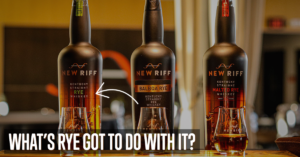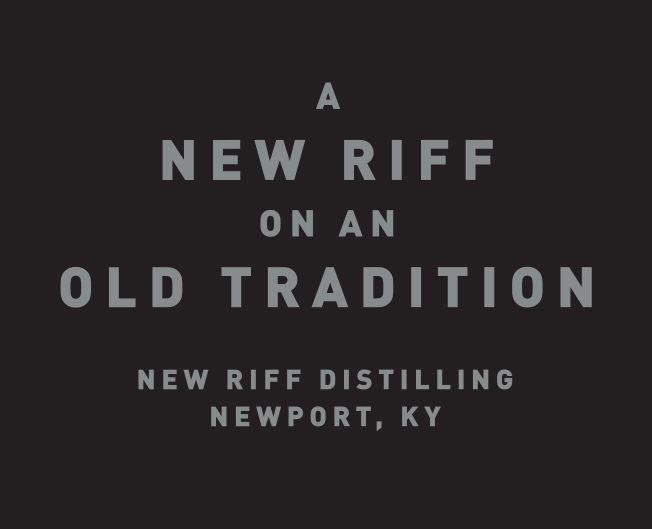
Our Co-Founder Jay Erisman, also known to many as “the whiskey man,” shares what that mean for the New Riff identity and taste – and why it really matters.
We had decided early on, well before Larry’s involvement, that we wanted to have an identity as a rye house, a mostly Bourbon distillery that had a focus on rye, on big and spicy flavors derived from rye. In our years at The Party Source, we had seen a shift in the treatment of rye, a shift in consumer preference and also in how American whiskeys were made and appreciated. And frankly, our own appreciation for rye grew greatly in this time as well.
The return, from approximately 2004, of Four Roses straight Bourbon to the U.S. market marked a new high mark in rye-recipe Bourbon. Four Roses’ two grain bills, one at 20% rye and the other, at 35%, the highest in the industry, and their subsequent great success in the marketplace introduced American consumers to the concept of high-rye Bourbon recipes. No longer was rye treated as a modest flavoring grain of 12-14% of a recipe—in the hands of Four Roses it was a blast of flavor, as these hugely spicy, intense Bourbons took off. Together with high rye Bourbons from LDI in Indiana, American whiskey lovers were introduced to the concept of “high rye” as they never had been before. Corollary to this was the explosive growth of straight rye whiskey, which was dominated by (you guessed it), Larry Ebersold’s 95% Indiana-distilled rye. Hordes of small distillers and bottlers rapidly expressed that whiskey into craft bottled whiskey brands. Suddenly, big rye was a big thing.
[Did you miss Part 1 of Jay Erisman’s Celebration of Rye?]
To compare it to a culinary trend, consider the growth of spicy food in America. From a country that had, at best, Tabasco sauce on the table, we now buy more salsa than ketchup, and every sports facility in the country has jalapeños-on-nachos. Not only that, but extreme flavors have become popular—look how many things are habanero-chile-flavored now. In the space of a generation, we became a nation of hotheads. The same thing happened in beer and hops, and coffee/espresso.
So for New Riff, going high rye was a response to current flavor trends. But more than that, we thought it would set us apart, somewhat, from the rest of the Kentucky industry. Most of the big distillers at the time treated rye as an afterthought; they all hated making it, they thought it was a fad that would go away (rather than recognizing it as the deep cultural shift that it was), and certainly didn’t want to make whiskeys that went outside the perceived comfort zone of their customers. Finally, rye costs a lot more than corn, and all those big corporations answer to beancounters and shareholders as well as whiskey lovers.
Finally, we wanted to claim, or reclaim, a bit of space for Greater Cincinnati’s tremendous whiskey heritage. At the turn of the 20th century, Cincinnati was unquestionably the center of the American whiskey industry. Rye whiskey always had a good profile in Cincinnati, perhaps a bit more so than in the wider Kentucky industry. Rye was a bit of a specialty in Ohio’s distilleries, especially up around Troy where Hayner’s did a big business in rye (and farm distilleries like Indian Creek in New Carlisle, Ohio—astonishingly, still in production today after its 1819 founding—focused solely on rye). Such local distilleries as Rossville-Union in Lawrenceburg, Indiana (today’s MGP) and the large Freiberg & Workum distillery in Lynchburg, Ohio each cranked out rye in various iterations (including malted rye). All that rye had to go somewhere, and where it went was the rectifiers and blenders and distillers of Cincinnati’s titanic whiskey industry, on both sides of the river.
Our first trial runs in late June 2014 used a Bourbon mashbill of 20% rye, 75% corn and 5% malted barley. This was suggested by Larry; it was similar to the Bourbon he made at Indiana and a good starting point for us. Soon after, we tried a 30% rye mash, we REALLY liked that, and that’s been our Bourbon mash bill ever since. Our rye began as a near-clone of Larry’s Legend, 95% rye and 5% malted barley. In early October we changed that to 5% malted rye, and we really like that too. Those two core whiskeys have remained unchanged since.
[Jay discusses New Riff 100% Malted Rye Whiskey]
There are a couple of points to make about these shifts. One, while we took some initial direction from Master Larry, we certainly wanted to branch out and find our own way. Perhaps more important, we didn’t come into New Riff with a lot of preconceived notions about things like mashbills. We thought it would be foolish to blithely assume that some given mashbill was the “perfect” Bourbon mashbill. We needed to make whiskey here at this site, with this water and these microbes and this equipment. (Not to mention with these people.) No one ever made whiskey here before—what should it be? We don’t know! We approached this task, this monumental task of founding a new (and hopefully great) whiskey distillery humbly and reverently. We almost let the whiskey make us, instead of the other way around. We might even change the mashbill again someday.
We use a lot more rye than most Bourbon distilleries. Between our high-rye Bourbon recipes and our 95% rye, on an annual basis we astonishingly use about 20% more rye grain than corn, surely the first time this has ever happened in the Kentucky whiskey industry. And we do the thing Seagram’s never would and make a 100% malted rye. It’s worth examining why the rest of the industry uses less rye and why we use more. A big, big reason why other Bourbon distillers, historically and today, use less rye is very simple: it’s expensive. It costs a lot more than corn, typically twice as much. These large companies have profits to make, shareholders to satisfy and dividends to pay out, and beancounters to answer to. They don’t make the quality-driven decisions that a smaller distiller can. Rye (and to a lesser extent barley) is considered the “flavoring grain” in a mashbill, and we view “more rye” simply as “more flavor.” Our mashbill is merely one example of the costly, quality-minded choices we make as distillers at New Riff.
Get the latest blogs and news from New Riff.
STAY IN TOUCH
Get updates on upcoming events and news from New Riff Gives.
